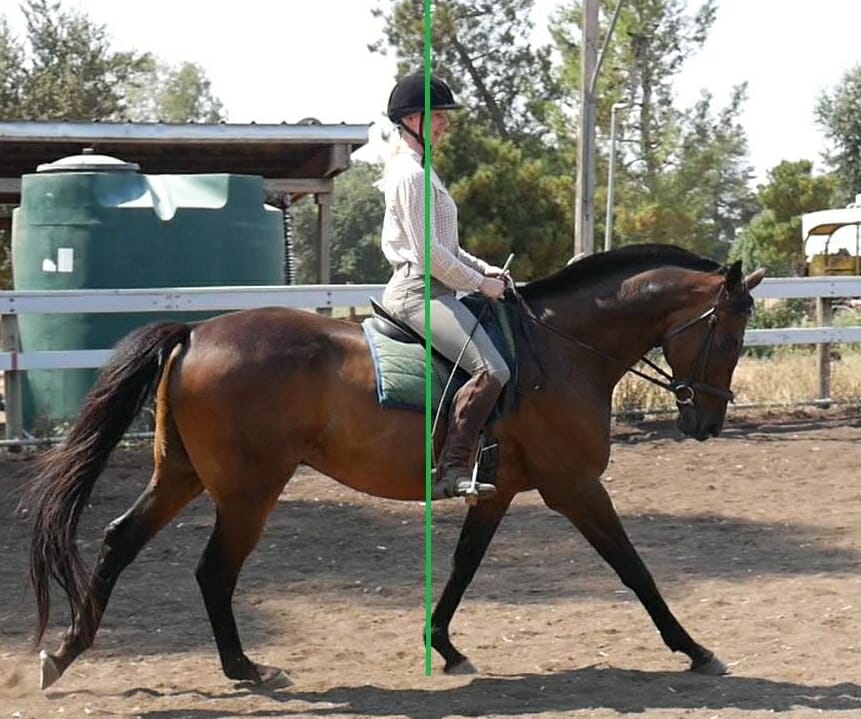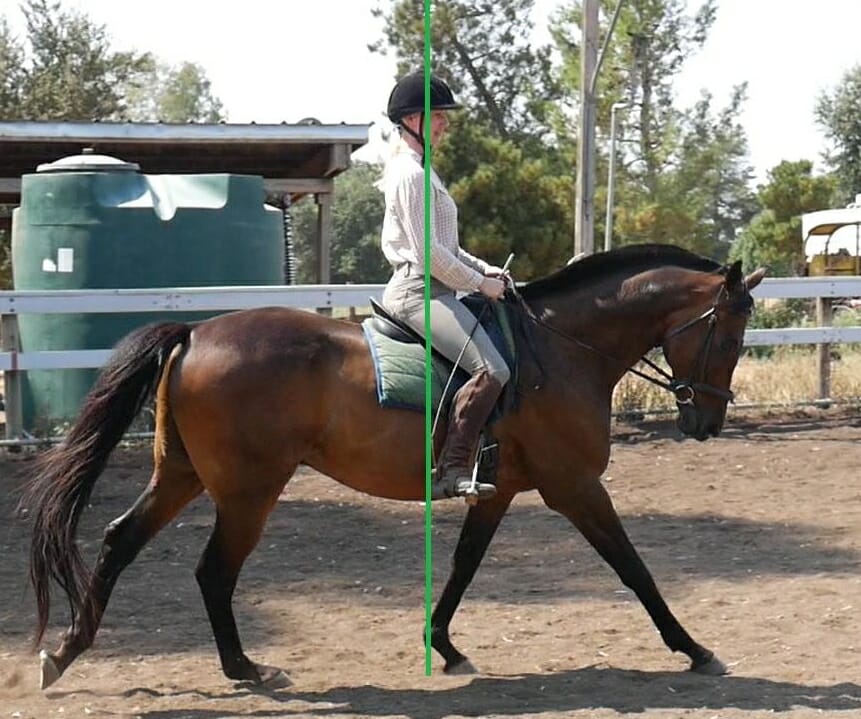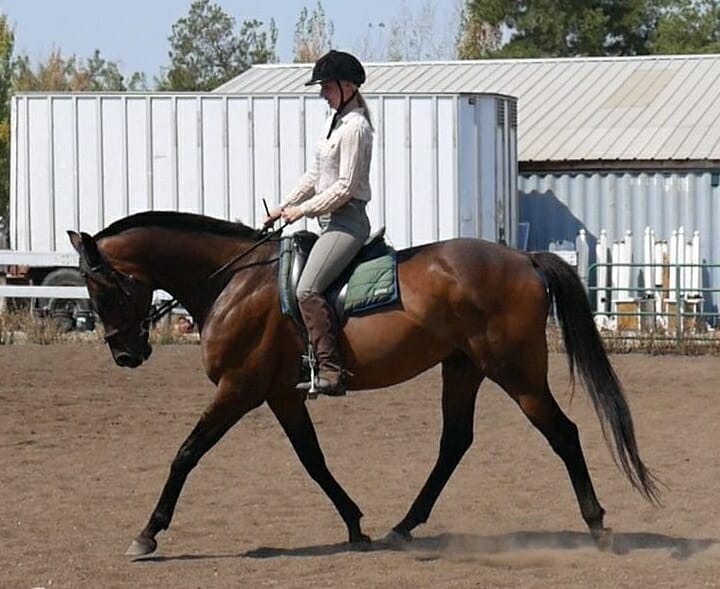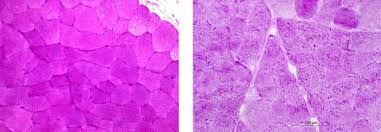How to Determine your Horse’s Laterality
First posted at http://www.equine-rehab.com/handedness-in-horses/ by Ann Ramsey CERA, Apf
 Just like people, a horse may be either right or left “handed”. In quadrupeds this is known as forelimb dominance or laterality. Whatever term you use, one sided dominance of the limbs is a common occurrence in many species. From an evolutionary standpoint, having one side of the body be more coordinated and sensitive is an advantage; the brain can concentrate more energy on only one dominant forelimb and conserve the energy of fully coordinating both. Also notable is that the brain creates a map of the entire body based on sensory input and energy used in animating each leg. The dominant forelimb is represented as larger in the brain’s model than the opposite limb.
Just like people, a horse may be either right or left “handed”. In quadrupeds this is known as forelimb dominance or laterality. Whatever term you use, one sided dominance of the limbs is a common occurrence in many species. From an evolutionary standpoint, having one side of the body be more coordinated and sensitive is an advantage; the brain can concentrate more energy on only one dominant forelimb and conserve the energy of fully coordinating both. Also notable is that the brain creates a map of the entire body based on sensory input and energy used in animating each leg. The dominant forelimb is represented as larger in the brain’s model than the opposite limb.
Unlike in humans, a horse’s handedness may be harder to discern. I’ll do my best to break down the assessment. In all the following scenarios I will describe a right-handed horse’s movement. This is because many if not most horses are, (like humans) right forelimb dominant. The reasons proposed for this range from foal position in utero, to human handling from birth. No one really knows the cause, but horse people throughout history have observed that generally horses work better to the left and find balancing and bending to the right more challenging.
Laterality in Quadrupeds
According to the late Dr. Kerry Ridgway, the dominant foreleg is the one they like to keep underneath themselves. They balance their trunk weight better over this limb and can “catch” themselves best on this leg when moving at speed. Imagine you are falling forward onto all fours (better yet get on the ground and walk on your hands and knees to really feel this). If you are right handed, you will catch your body and break your fall most likely with your right arm. This is essentially how horses move. They propel their body forward from the hindlimbs and catch and support their trunk with the front limbs.
Good Direction, Tough Direction
Most horse people have experienced this, each horse has a direction that feels balanced and easy to ride. In the opposite direction it is more challenging to bend and balance. This is usually most noticeable at the canter, but the phenomenon is discernable in all gates. Discerning handedness is horses can be a bit counter intuitive, but is straightforward if you understand the phases of the gait you’re looking at.
Here’s an example. A right forelimb dominant horse will have an easier time working on the left rein. This makes sense because the horse traveling to the left is supporting its trunk weight on the outside forelimb. At the canter, the right-handed horse will work better to the left because during the second beat of the canter, the horse is catching its trunk weight with the outside right forelimb.
Above : A horse in a right lead canter, is shown catching its trunk weight on the outside, left forelimb
The same is true for the trot. This principal understanding of equine movement is why the rising trot is coordinated with the outside foreleg. Riders sit when the outside forelimb is under the body.
Above : A horse trotting on the left rein is shown catching its trunk weight with the outside, right forelimb.
In a nut shell, a right forelimb dominant horse will work better going to the left. A left forelimb dominant horse will work better going to the right. Discerning which forelimb is dominant in your horse takes a bit of observation, but can be seen very easily if you know what to look for.
Visually Assess Your Horse
If you put your horse on a lounge line, or free lounge him in a round pen you will be able to discern his handedness by noting which side he prefers. A right-handed horse moving to the left will tend to naturally bend inward and will often make the circle larger. When going to the right, the horse will counter bend his body and look outward. He may make the circle smaller and will look like he’s leaning or falling in on the circle. This is because the horse is trying to maintain what is most comfortable for him, which is to catch the trunk weight of the body on the right foreleg.
Consequences of Asymmetrical Movement
Knowing your horse’s forelimb dominance will help explain his overall posture and behavior patterns. This information should be used to better tailor his care: everything from training to hoof care, to saddle fit, to chiropractic and bodywork therapies will be enhanced by this information. Sadly, If the handedness of the horse is not addressed the dominant forelimb can become over taxed. The leg that is repeatedly overloaded will almost certainly develop pain and ultimately pathology if given enough time. Joint disease such as osteoarthritis, or soft tissue injuries to tendons and ligaments could occur. Bone abnormalities like side bone and ringbone may occur if an animal’s movement is asymmetrical throughout its lifetime. Repeated traumas can cause permanent lameness, something we as horse owners are determined to avoid. So, training should incorporate knowledge of the individual horse’s handedness and address it as early as possible.
Strategies and Solutions
In the young horse reducing asymmetrical movement through training can accomplish a lot. Starting with ground work and lounging the horse must be taught to bend and balance in both directions. Through the consistent use of correct lateral bending, the horse can learn to catch his trunk weight on both forelimbs more equally. Later in the ridden work, targeted exercises like shoulder-in, and haunches-in can be used to further improve balance and strengthen the carrying power of each hind limb. Leg yields are a wonderful way to teach a horse to balance and move sideways on both reins. The key is to work symmetrically and consistently in good balance in each direction. Though the horse’s innate handedness is never eliminated, an overall evenness and straightness of movement can be achieved. Good training requires a full understanding of laterality. If you hire a trainer, be sure to ask how they approach handedness in a horse’s work routine. If you are training your own horse, be sure to identify his individual handedness and incorporate this knowledge into all his care.
References
1. Chapter 23 page 368 of Care and Rehabilitation of the Equine Foot by Pete Ramey, titled High Heel/Low Heel Syndrome by Kerry Ridgway,DVM
2 Atlas of Equine Anatomy by Chris Pasquini 3rd edition 1991 Sudz Publishing
3. Article titled Chimp Handedness by Michael Price, 2009 American Psycological Association
http://www.apa.org/monitor/2009/01/chimps.aspx
4. Article titled Parrots prefer ‘left handedness’ by Emma Brennand, Published by BBC Earth News http://news.bbc.co.uk/earth/hi/earth_news/newsid_9382000/9382181.stm







